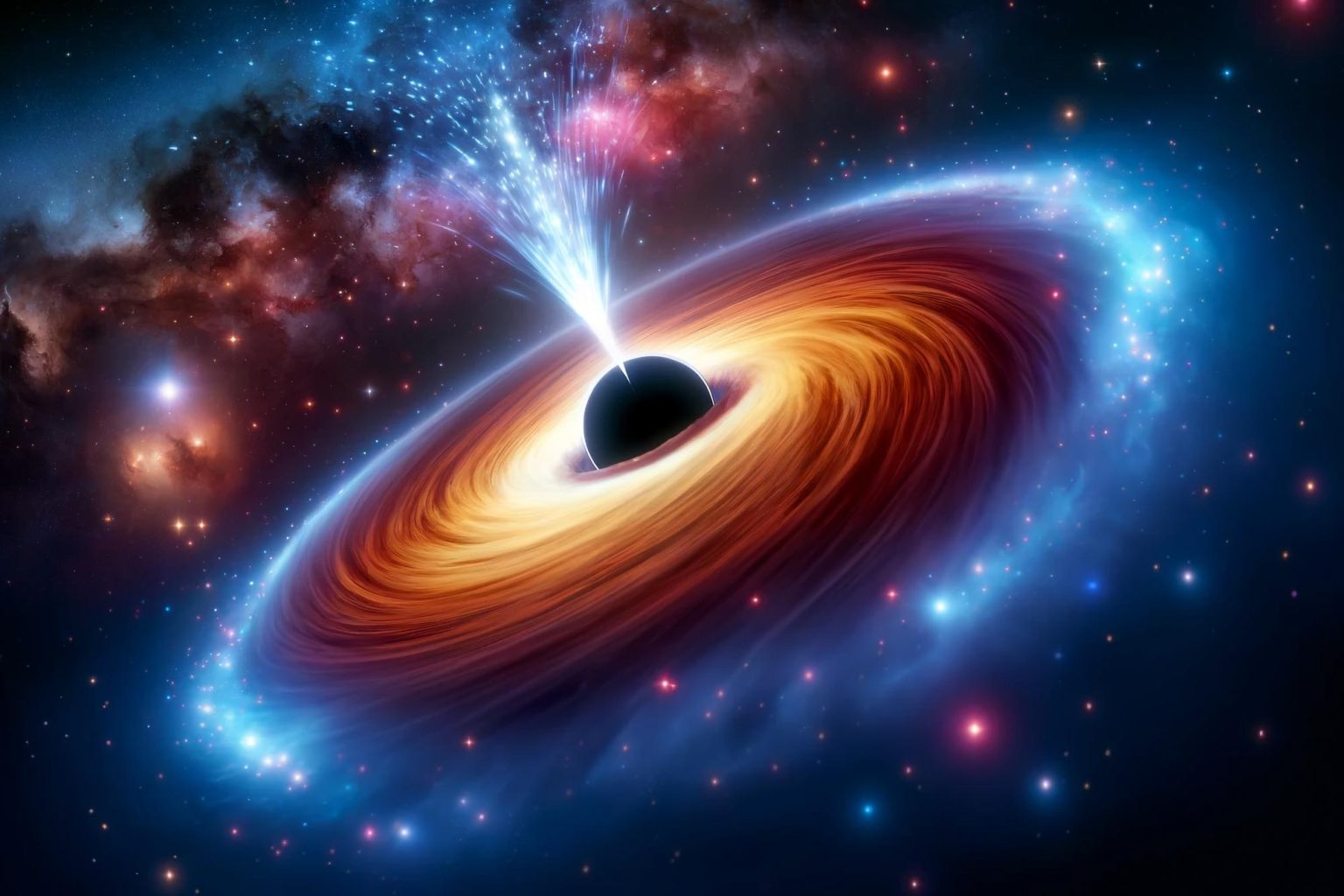"In a distant galaxy, a supermassive black hole’s intermittent gas plumes led to the discovery of a smaller black hole in its orbit, challenging conventional black hole accretion disk theories and suggesting such dynamic systems may be more common. Credit: SciTechDaily.com" (ScitechDaily, Black Hole “Hiccups” – Astronomers Stunned by Periodic Outbursts in Far-Off Galaxy)
High-energy plasma orbits every black hole. That intensive plasma is called plasma or material disk. The high-energy plasma. Along with the spinning black hole causes a situation where light and other electromagnetic fields are elliptically polarized. High-speed material whirling with intensive energy causes a situation, where radiation or wave movement turns into a spiral-shaped structure.
In a black hole's event horizon, the intensive energy field also takes the gravity field to the whirl-shaped movement. The idea is this: when energy density turns high enough, it can interact with other energy forms. All energy forms from electromagnetism to gravity are wave movements. And the only thing, that makes a difference in those four fundamental interactions is the wavelength.
If the energy level is high enough. That means electromagnetism can interact directly with weak interaction. When the energy level rises high enough, weak interaction can interact with strong nuclear force or strong interaction. And finally, all four forces can interact with each other. When strong interaction has a high enough energy level, that takes gravity with it. So in black holes, all four fundamental forces interact with each other.
Image above: The black holes behave a little bit like quantum dots. "Accurate alignment of quantum dots with photonic components is critical for extracting the radiation emitted by the dots. In this illustration, a quantum dot centered in the optical “hotspot” of a circular grating (center dot in the inset) emits more light than a dot that is misaligned (off-center dot in the inset). Credit: S. Kelley/NIST" (ScitechDaily, Bullseye Precision: NIST’s Breakthrough in Quantum Dot Alignment)
The idea is that in the black holes are pure gravitons. One of the possibilities of the graviton's shape is that a graviton is like an electron hole, but the particle that forms that hole is a photon. Theoretically is possible that some other particles can form similar holes as electrons. The electron hole means that one electron's energy level decreases. In some cases, the free electron has a very low energy level.
In this case, it takes another electron orbit to that hole. This thing forms a quasiparticle called exciton. Theoretically is possible that a photon can form a photon hole when its energy level decreases to a very low level. In that case, a photon can start to orbit that other photon. And in that case, this thing forms a theoretical thing called: "photonic exciton".
"The Event Horizon Telescope (EHT) collaboration, which produced the first-ever image of our Milky Way black hole released in 2022, has captured a new view of the massive object at the center of our Galaxy: how it looks in polarized light. This is the first time astronomers have been able to measure polarization, a signature of magnetic fields, this close to the edge of Sagittarius A*. This image shows the polarized view of the Milky Way black hole. The lines overlaid on this image mark the orientation of polarization, which is related to the magnetic field around the shadow of the black hole. Credit: EHT Collaboration" (ScitechDaily, Peering Into the Magnetic Soul of the Milky Way’s Central Black Hole)
Black holes have no magnetic fields themselves. The plasma around them makes that intensive electromagnetic phenomenon. And that magnetic field makes plasma travel to the black hole's poles or the spin-axle. This impact forms a very strong fusion reaction. Most of the black hole's visible jets form at those points. The black hole gets its energy from that plasma ring. The black hole's hiccups form when the symmetry in that energy changes.
The plasma around the black hole acts like all other plasma. It follows magnetic lines. Fusion reaction at the black hole's spin axle forms when that high-energy plasma impacts there. Nothing can escape from the black hole. But lots of material escapes from the black hole's plasma ring called transition- or material disk.
An intensive gravitational field forms the situation, that all radiation falls into a black hole. That radiation impacts the middle of that object. If a black hole goes in the middle of nowhere, like in a false vacuum it vaporizes. When a black hole gets hiccups, it releases gravitational waves.
Those gravitational waves can form in this case. Where gravitational waves impact in the middle of a black hole. Gravitational waves interact like all other radiation. And that means the gravitational field can also polarize other gravitational fields.
https://scitechdaily.com/black-hole-hiccups-astronomers-stunned-by-periodic-outbursts-in-far-off-galaxy/
https://scitechdaily.com/bullseye-precision-nists-breakthrough-in-quantum-dot-alignment/
https://scitechdaily.com/peering-into-the-magnetic-soul-of-the-milky-ways-central-black-hole/
https://scitechdaily.com/quantum-lights-goldilocks-zone-perfecting-elliptical-polarization/







No comments:
Post a Comment
Note: Only a member of this blog may post a comment.